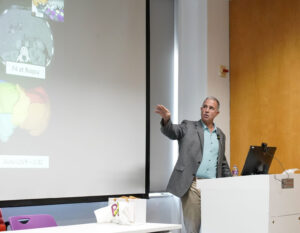
This fall, Perry Pickhardt, MD spent two weeks touring China, building interdisciplinary relationships and delivering talks on the use of artificial intelligence (AI) in radiology. The tour was part of Dr. Pickhardt’s Distinguished Scientist, President’s International Fellowship Initiative (PIFI) award that he received from the Chinese Academy of Science (CAS).
Open to scientific research personnel worldwide, PIFI encourages scientific cooperation and promotes research communication globally. Xin Gao, PhD, an expert on AI and imaging technology research at the Suzhou Institute of Biomedical Engineering and Technology, nominated Dr. Pickhardt for the Distinguished Scientist award. Drs. Pickhardt and Gao have previously collaborated on a multicenter research project to develop and evaluate a deep learning model to diagnose rectal cancer.
Dr. Pickhardt spoke at several institutions throughout China. In his lectures, he focused on how AI can be leveraged in radiology; highlighting his work on opportunistic screening and estimating biological age using CT biomarkers.

Both topics utilize AI-based tools to analyze characteristics of a patient’s CT scan that would otherwise be time consuming in a clinical setting. Typically, a patient undergoes a CT scan to determine a diagnosis, like the cause of acute abdominal pain. Opportunistic screening goes a step further by looking at the additional metrics such as bone mineral density, skeletal muscle, and liver fat; which can be used to evaluate the patient’s overall health and wellness.
In a related sense, biological age estimations use metrics from CT scans to form a predictive model that appears to outperform other metrics like chronological age and epigenetic data. In clinical settings, this could help health care professionals better understand the characteristics that may be causing a higher biological age in a patient and tailor medical and lifestyle changes to lower the advanced biological age.
In addition to his lectures, Dr. Pickhardt engaged in the culture such as visiting the famed Terracotta Army and other UNESCO World Heritage Sites.